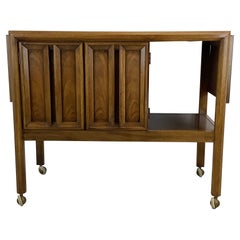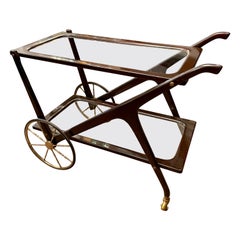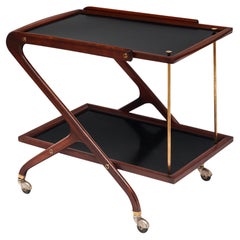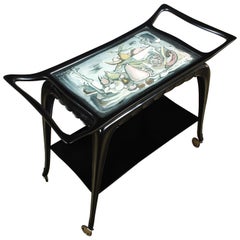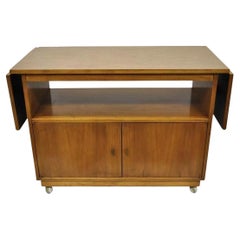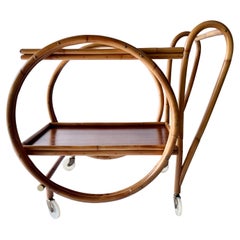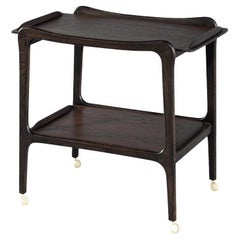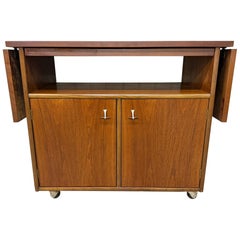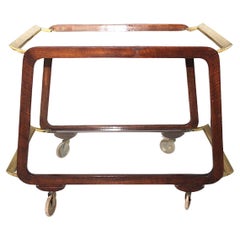Mid Century Bar Cart Walnut
Mid-20th Century Unknown Mid-Century Modern Carts and Bar Carts
Wood
Mid-20th Century Italian Mid-Century Modern Carts and Bar Carts
Brass
Vintage 1950s Italian Mid-Century Modern Carts and Bar Carts
Brass
Vintage 1940s Italian Mid-Century Modern Carts and Bar Carts
Walnut
Mid-20th Century Unknown Mid-Century Modern Carts and Bar Carts
Laminate, Walnut
Vintage 1960s American Mid-Century Modern Carts and Bar Carts
Brass
Vintage 1970s American Mid-Century Modern Carts and Bar Carts
Teak
Mid-20th Century American Mid-Century Modern Carts and Bar Carts
Laminate, Wood, Walnut
Mid-20th Century Austrian Mid-Century Modern Carts and Bar Carts
Brass
Vintage 1950s Italian Mid-Century Modern Carts and Bar Carts
Brass
Mid-20th Century French French Provincial Carts and Bar Carts
Walnut
20th Century Swedish Mid-Century Modern Carts and Bar Carts
Brass
Vintage 1960s American Mid-Century Modern Carts and Bar Carts
Brass
Mid-20th Century Mid-Century Modern Carts and Bar Carts
Brass
Mid-20th Century Italian Mid-Century Modern Carts and Bar Carts
Walnut
Vintage 1960s German Mid-Century Modern Carts and Bar Carts
Metal
Mid-20th Century English Mid-Century Modern Carts and Bar Carts
Iron
Vintage 1950s Italian Mid-Century Modern Carts and Bar Carts
Brass
Vintage 1960s American Mid-Century Modern Carts and Bar Carts
Walnut
Vintage 1950s American Mid-Century Modern Carts and Bar Carts
Walnut
Mid-20th Century Italian Mid-Century Modern Carts and Bar Carts
Mahogany, Walnut
Vintage 1960s Austrian Mid-Century Modern Carts and Bar Carts
Brass
Vintage 1950s American Mid-Century Modern Carts and Bar Carts
Walnut
Vintage 1960s Italian Mid-Century Modern Carts and Bar Carts
Brass
Mid-20th Century American Mid-Century Modern Carts and Bar Carts
Brass
Mid-20th Century Italian Mid-Century Modern Carts and Bar Carts
Metal, Chrome
Mid-20th Century Italian Mid-Century Modern Carts and Bar Carts
Metal, Chrome
Vintage 1960s American Mid-Century Modern Carts and Bar Carts
Walnut
Vintage 1960s Mid-Century Modern Carts and Bar Carts
Walnut
Mid-20th Century Italian Mid-Century Modern Carts and Bar Carts
Metal, Chrome
Vintage 1960s Italian Mid-Century Modern Carts and Bar Carts
Laminate, Walnut
Mid-20th Century English Art Deco Carts and Bar Carts
Walnut
Vintage 1950s American Industrial Carts and Bar Carts
Aluminum
Mid-20th Century Carts and Bar Carts
Walnut
Mid-20th Century Carts and Bar Carts
Walnut
Vintage 1960s American Mid-Century Modern Carts and Bar Carts
Brass, Steel
Mid-20th Century Italian Neoclassical Revival Carts and Bar Carts
Walnut
Mid-20th Century English Art Deco Carts and Bar Carts
Walnut
Vintage 1950s Italian Hollywood Regency Carts and Bar Carts
Brass
Vintage 1960s Italian Mid-Century Modern Carts and Bar Carts
Brass
Mid-20th Century Italian Mid-Century Modern Carts and Bar Carts
Brass
Vintage 1950s American Mid-Century Modern Carts and Bar Carts
Walnut
Vintage 1930s Italian Mid-Century Modern Carts and Bar Carts
Metal, Chrome
Mid-20th Century Mid-Century Modern Carts and Bar Carts
Walnut, Lacquer
Vintage 1970s American Mid-Century Modern Carts and Bar Carts
Aluminum
Vintage 1950s Italian Mid-Century Modern Carts and Bar Carts
Crystal
Vintage 1960s Italian Mid-Century Modern Carts and Bar Carts
Iron
Mid-20th Century Polish Art Deco Carts and Bar Carts
Walnut, Glass
Vintage 1960s American Mid-Century Modern Carts and Bar Carts
Walnut
20th Century American Mid-Century Modern Carts and Bar Carts
Metal
21st Century and Contemporary American Mid-Century Modern Carts and Bar ...
Brass
Vintage 1940s American Mid-Century Modern Carts and Bar Carts
Metal, Aluminum
Mid-20th Century North American Mid-Century Modern Carts and Bar Carts
Walnut
Vintage 1960s Italian Mid-Century Modern Carts and Bar Carts
Metal, Brass
Mid-20th Century Italian Mid-Century Modern Carts and Bar Carts
Brass
Vintage 1960s American Mid-Century Modern Carts and Bar Carts
Formica, Wood
Mid-20th Century English Art Deco Carts and Bar Carts
Walnut
Mid-20th Century Italian Mid-Century Modern Carts and Bar Carts
Glass, Walnut
- 1
- ...
Mid Century Bar Cart Walnut For Sale on 1stDibs
How Much is a Mid Century Bar Cart Walnut?
A Close Look at Mid-century Modern Furniture
Organically shaped, clean-lined and elegantly simple are three terms that well describe vintage mid-century modern furniture. The style, which emerged primarily in the years following World War II, is characterized by pieces that were conceived and made in an energetic, optimistic spirit by creators who believed that good design was an essential part of good living.
ORIGINS OF MID-CENTURY MODERN FURNITURE DESIGN
- Emerged during the mid-20th century
- Informed by European modernism, Bauhaus, International style, Scandinavian modernism and Frank Lloyd Wright’s architecture
- A heyday of innovation in postwar America
- Experimentation with new ideas, new materials and new forms flourished in Scandinavia, Italy, the former Czechoslovakia and elsewhere in Europe
CHARACTERISTICS OF MID-CENTURY MODERN FURNITURE DESIGN
- Simplicity, organic forms, clean lines
- A blend of neutral and bold Pop art colors
- Use of natural and man-made materials — alluring woods such as teak, rosewood and oak; steel, fiberglass and molded plywood
- Light-filled spaces with colorful upholstery
- Glass walls and an emphasis on the outdoors
- Promotion of functionality
MID-CENTURY MODERN FURNITURE DESIGNERS TO KNOW
- Charles and Ray Eames
- Eero Saarinen
- Milo Baughman
- Florence Knoll
- Harry Bertoia
- Isamu Noguchi
- George Nelson
- Danish modernists Hans Wegner and Arne Jacobsen, whose emphasis on natural materials and craftsmanship influenced American designers and vice versa
ICONIC MID-CENTURY MODERN FURNITURE DESIGNS
- Eames lounge chair
- Nelson daybed
- Florence Knoll sofa
- Egg chair
- Womb chair
- Noguchi coffee table
- Barcelona chair
VINTAGE MID-CENTURY MODERN FURNITURE ON 1STDIBS
The mid-century modern era saw leagues of postwar American architects and designers animated by new ideas and new technology. The lean, functionalist International-style architecture of Le Corbusier and Bauhaus eminences Ludwig Mies van der Rohe and Walter Gropius had been promoted in the United States during the 1930s by Philip Johnson and others. New building techniques, such as “post-and-beam” construction, allowed the International-style schemes to be realized on a small scale in open-plan houses with long walls of glass.
Materials developed for wartime use became available for domestic goods and were incorporated into mid-century modern furniture designs. Charles and Ray Eames and Eero Saarinen, who had experimented extensively with molded plywood, eagerly embraced fiberglass for pieces such as the La Chaise and the Womb chair, respectively.
Architect, writer and designer George Nelson created with his team shades for the Bubble lamp using a new translucent polymer skin and, as design director at Herman Miller, recruited the Eameses, Alexander Girard and others for projects at the legendary Michigan furniture manufacturer.
Harry Bertoia and Isamu Noguchi devised chairs and tables built of wire mesh and wire struts. Materials were repurposed too: The Danish-born designer Jens Risom created a line of chairs using surplus parachute straps for webbed seats and backrests.
The Risom lounge chair was among the first pieces of furniture commissioned and produced by celebrated manufacturer Knoll, a chief influencer in the rise of modern design in the United States, thanks to the work of Florence Knoll, the pioneering architect and designer who made the firm a leader in its field. The seating that Knoll created for office spaces — as well as pieces designed by Florence initially for commercial clients — soon became desirable for the home.
As the demand for casual, uncluttered furnishings grew, more mid-century furniture designers caught the spirit.
Classically oriented creators such as Edward Wormley, house designer for Dunbar Inc., offered such pieces as the sinuous Listen to Me chaise; the British expatriate T.H. Robsjohn-Gibbings switched gears, creating items such as the tiered, biomorphic Mesa table. There were Young Turks such as Paul McCobb, who designed holistic groups of sleek, blond wood furniture, and Milo Baughman, who espoused a West Coast aesthetic in minimalist teak dining tables and lushly upholstered chairs and sofas with angular steel frames.
Generations turn over, and mid-century modern remains arguably the most popular style going. As the collection of vintage mid-century modern chairs, dressers, coffee tables and other furniture for the living room, dining room, bedroom and elsewhere on 1stDibs demonstrates, this period saw one of the most delightful and dramatic flowerings of creativity in design history.
Finding the Right Bar-carts for You
Forever a sleek and elegant furnishing that evokes luxury and sophistication, a vintage bar cart will prove both functional and fabulous in your living room.
Bar carts as we know them were originally conceived as tea trolleys — a modest-sized table on wheels, sometimes featuring both an upper and lower shelf — to help facilitate tea service during the Victorian era in England. Modern bar carts weren’t really a common fixture in American interiors until after the end of Prohibition in the 1930s, when they were rolled onto the sets of Hollywood films. There, they suggested wealth and status in the dining rooms of affluent characters.
As tough as the 1930s had been on the average working American, the postwar era yielded economic stability and growth in homeownership. Increasingly, bar carts designed by the likes of Edward Wormley and other furniture makers became an integral part of sunken living rooms across the United States in the 1950s.
Bar carts were a must-have addition to the sensuous and sleek low-profile furnishings that we now call mid-century modern, each outfitted with the finest spirits and savory snacks that people had to offer. And partially owing to critical darlings like Mad Men, vintage cocktail carts have since seen a resurgence and have even become a selling point in restaurants.
Bar carts not only boast tremendous utilitarian value but also introduce a fun, nostalgic dynamic to the layout of your space, be it in the bar area or elsewhere. In addition to showcasing your favorite bottles of rye and local small-batch gin — or juices and mocktail ingredients — there is an undeniable allure to stacking statement glassware, vintage martini cocktail shakers and Art Deco decanter sets atop your fully stocked mid-century modern bar cart. And one size or style doesn’t fit all — an evolution of cocktail cart design throughout history has yielded all manner of metal bar carts, rattan carts and more.
We invite you to add a few more dashes of class to cocktail hour — peruse the vast collection of antique and vintage carts and bar carts on 1stDibs today.
Read More
The Ultimate Guide to Types of Tables for the Home
Whether you’re just moving in or ready to give your home a makeover, our guide will give you pointers on tables that are fitting for every room, nook and hallway.
May’s Most Popular Interiors on Instagram
Our feed is filled with the world's most beautiful spaces. See the rooms our followers have deemed the best of the best this month.
New Orleans’ Lee Ledbetter Makes Design Magic by Mixing Past and Present
The Louisiana-born and -bred architect talks to 1stdibs about the art of making timeless places that matter.
Desert Modern Designer Arthur Elrod Finally Gets His Day in the Sun
The Palm Springs interior decorator developed a mid-century style that defined the vacation homes of celebrities and other notables, including Bob Hope and Lucille Ball.
From the Hamptons to Palm Springs, FormArch’s Homes Embody Both Comfort and Cool
The houses from this New York studio cloak modernist tendencies within what are often more traditional trappings.
